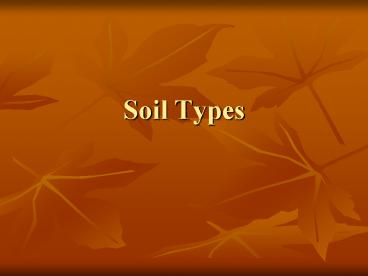Soil Types - PowerPoint PPT Presentation
Title:
Soil Types
Description:
Soil Types Quick Review 1. What is the process that forms soil? - weathering 2. What are the two types of weathering? What causes them? - physical (rain, snow sleet ... – PowerPoint PPT presentation
Number of Views:224
Avg rating:3.0/5.0
Title: Soil Types
1
Soil Types
2
Quick Review
- 1. What is the process that forms soil?
- - weathering
- 2. What are the two types of weathering? What
causes them? - - physical (rain, snow sleet, hail)
- - chemical (acids)
- 3. What is another name for a layer of soil?
- - horizon
3
More Review!
- 4. What is the name for soil that has a lot of
decaying organic material? - - humus
- 5. Which layer is most important for plant
growth? - - topsoil
- 6. What is the main cause of desertification?
- - improper management of soil which leads to
erosion.
4
Types of Soils
- Soil is classified according to the type of
mineral base and the size of the particles. - There are 3 types
5
1. Sand
- Very large particles
- Feels rough
- Does not hold water or nutrients well.
6
2. Silt
- Particles are smaller than those in sand
- Feels smooth and powdery
7
3. Clay
- Has very small particles, and gums together.
- It holds water and nutrients well, but plants
roots cant grow well. - While it holds water well, it takes a long time
for water to permeate a clay soil. - Brief, heavy rains may not reach plant roots.
8
Loam
- Mixture of sand, silt, and clay and organic
matter. - Water and nutrient holding abilities vary with
composition.
9
Which type is best?
- The ideal type of soil for plant (crop) growth is
partway between these two extremes. - Loamy soil has neither too small nor too large
particles (Its just right!) - Loamy soil has a good percentage of decayed plant
material or humus which provide the nutrients
that plants need.
10
Further Resources
- National Resources Conservation Service website.
Try out the Web Soil Survey tool to see whats
under your feet - US Environmental Protection Agency
- Digging to China?
- Introduction to Soils

